Making a Covenant with Abraham (Part 3)
Read the series so far.
Covenants & Promises
The seventeenth chapter of the Book of Genesis affords us an occasion to distinguish between a covenant and a promise. This difference is seldom noticed in the literature, but it deserves our attention since it shows up a tendency to take things for granted which we ought perhaps to be more discerning about.




Discussion